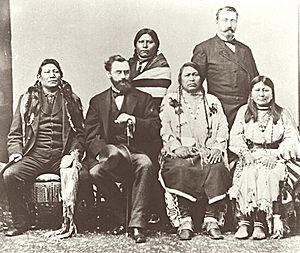Chief Ignacio facts for kids
Chief Ignacio (1828–1913) was an important leader of the Weeminuche band. They are part of the Ute tribe, a group of Native Americans. The Weeminuche lived in what is now Colorado, near the San Juan River.
Chief Ignacio guided his people during a challenging time in the late 1800s. During these years, more and more European-American settlers moved onto Ute lands.
Contents
Protecting Ute Lands
Chief Ignacio worked hard to protect his people's way of life. He wanted to keep their traditional lands safe.
The Washington Trip
In January 1880, Chief Ignacio traveled to Washington, D.C. He was part of a group of Ute leaders. They went to speak to the US Congress. They talked about problems that had happened with some northern Ute bands. Even though the Weeminuche had not been involved in these problems, many settlers wanted all Utes to leave their homes.
The Ute leaders tried to find a peaceful solution. However, later that year, Congress passed a law. This law forced many Ute people onto special areas called reservations. Unlike some other Ute groups, the Weeminuche and two other southern bands were able to stay in Colorado.
Southern Ute Reservation
The Weeminuche, along with the Muache and Capote Utes, settled on the Southern Ute Indian Reservation. This reservation is in southern Colorado. The main town on the reservation was named Ignacio to honor the chief.
Changes to Land Ownership
More challenges came with new laws about land. These laws aimed to change how Native American lands were owned.
The Dawes Act
In 1887, the US Congress passed a law called the Dawes Act. This law was meant to break up shared Native American lands. Instead of the whole tribe owning land together, families would get their own small plots. The idea was to make Native Americans live more like European-American farmers. Any extra land would then be sold to others.
In 1895, the Southern Utes voted on this idea. They narrowly agreed to divide their land.
Moving to New Areas
Chief Ignacio and the Weeminuche people did not want their land broken up. In 1896, they decided to move. They went to the western part of the Southern Ute Reservation.
Their descendants now live on the Ute Mountain Ute Reservation. The main office for their tribe is in Towaoc. The Ute Mountain Ute are one of three Ute tribes officially recognized by the US government.



